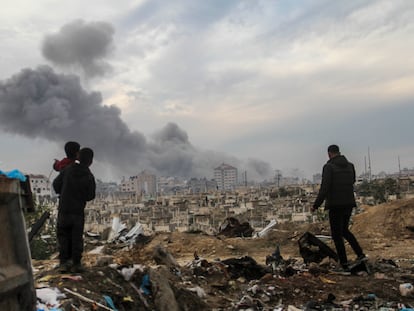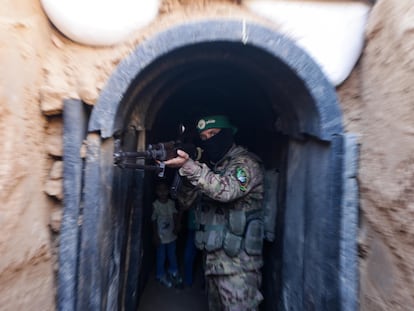Israel and Hamas reach initial ceasefire agreement in Gaza
The Netanyahu government plans to discuss and vote on the terms of the deal on Thursday. In the first of three phases of the plan, Hamas must hand over 33 hostages and Israel must begin a phased withdrawal of its troops in the northern Strip and start releasing Palestinian prisoners
After 15 months of war in Gaza, Israel and Hamas have reached a ceasefire agreement in principle, according to official sources from two of the mediating countries, the United States and Egypt, and from Israel. In the absence of an official announcement, the pact comes after 15 months of war and more than 46,700 people killed in the Strip and following weeks of arduous negotiations in Doha to decide the future of Gaza after the end of the conflict. The new ceasefire plan includes three phases. In the first, which would begin to be implemented swiftly after the signing of the agreement and would last six weeks, Hamas would hand over 33 hostages (an estimated one third of them lifeless and mostly women, minors, and the sick, wounded and those aged over 50). At the same time, Israel would begin the progressive withdrawal of its troops from northern Gaza and would start to release Palestinian prisoners held in Israeli jails.
The agreement comes after months of on-and-off negotiations with Egyptian and Qatari intermediaries, backed by the United States, and comes just before the January 20 inauguration of U.S. president-elect Donald Trump. Benjamin Netanyahu’s government is scheduled to assess and vote on the terms of the agreement Thursday, according to a Foreign Ministry release. Its head, Gideon Saar, has cut short a visit to Europe to return in time for the vote.
A “painful agreement”
Saar said that the ceasefire pact with Hamas “is a painful agreement,” because Israel will have to release “dangerous terrorists and murderers” in exchange for the release of the hostages still in Gaza. However, the Israeli Foreign Minister also acknowledged the importance of the pact as “it is very important for us that our men, our people, are released from captivity.”
Negotiating teams from the Israeli government and Hamas have been in talks in Doha, Qatar, to try to finalize the details of a plan to end the war in which emissaries have been discussing “technical points” of the three-phase agreement. In the first phase, Hamas would hand over 33 hostages from among the remaining 100 that the Palestinian party-militia and other Islamist groups have held since 7 October 2023. In exchange, Israel would begin the gradual withdrawal of its troops and free 1,000 Palestinian prisoners. The second phase will involve the withdrawal of the Israeli army from several other areas of the Strip, the return of Gazan civilians to northern Gaza and the handover of the remaining hostages, including the bodies of those who have been killed. The third and final part of the deal will include long-term discussions on the new administration that will govern the Strip.
Netanyahu warned that there were still “details” to be finalized that he hopes will be resolved during Thursday evening. The three-phase pact is expected to begin to be applied this week. The relief in the Strip is accompanied by awareness of the significant challenges that its implementation will present, especially the transition from one phase to another. Senior Hamas official Basem Naim said that his movement had given its affirmative response to the agreement. The exhausted population of Gaza and the relatives of Israeli hostages have begun to celebrate while cautiously holding their breath, aware that the final details in negotiations are often complicated and that previous moments of optimism in 2024 ended in disappointment.
The transition from one phase to the next is what raises the most fears. Families of hostages who were not included in the first group fear that negotiations will stall with their loved ones still to be released. Several relatives have expressed their opposition to the possibility of the population of northern Gaza being able to return to their homes in the first phase, with some of the hostages still in the hands of Hamas.
The Islamist movement, meanwhile, fears that Netanyahu will restart the bombings after obtaining some of the hostages. The Israeli prime minister is using the formula of a “long-term ceasefire” and is under pressure from his far-right government partners, who refuse to end the invasion and advocate maintaining a permanent military presence in Gaza and re-establishing Jewish settlements.
Trump hails “epic” ceasefire agreement
That the deal is being pushed through now is believed in large part to be due to the imminent return of Donald Trump to the White House. The president-elect had set the date of his inauguration as a deadline for reaching an agreement and everything seems to indicate that the message has been received not only by Hamas, but also by Netanyahu. The ceasefire agreement is essentially the same deal that Joe Biden’s administration presented last May. That was rejected by Netanyahu’s government but regained momentum ahead of Trump’s return to power.
On his social network Truth Social, Trump posted a message celebrating the deal. “We have a deal for the hostages in the Middle East. They will be released shortly. Thank you!”
In a subsequent post, the president-elect stated: “This EPIC ceasefire agreement could have only happened as a result of our Historic Victory in November, as it signaled to the entire World that my Administration would seek Peace and negotiate deals to ensure the safety of all Americans, and our Allies. I am thrilled American and Israeli hostages will be returning home to be reunited with their families and loved ones.
“With this deal in place, my National Security team, through the efforts of Special Envoy to the Middle East, Steve Witkoff, will continue to work closely with Israel and our Allies to make sure Gaza NEVER again becomes a terrorist safe haven. We will continue promoting PEACE THROUGH STRENGTH throughout the region, as we build upon the momentum of this ceasefire to further expand the Historic Abraham Accords. This is only the beginning of great things to come for America, and indeed, the World!”
Sign up for our weekly newsletter to get more English-language news coverage from EL PAÍS USA Edition
Tu suscripción se está usando en otro dispositivo
¿Quieres añadir otro usuario a tu suscripción?
Si continúas leyendo en este dispositivo, no se podrá leer en el otro.
FlechaTu suscripción se está usando en otro dispositivo y solo puedes acceder a EL PAÍS desde un dispositivo a la vez.
Si quieres compartir tu cuenta, cambia tu suscripción a la modalidad Premium, así podrás añadir otro usuario. Cada uno accederá con su propia cuenta de email, lo que os permitirá personalizar vuestra experiencia en EL PAÍS.
¿Tienes una suscripción de empresa? Accede aquí para contratar más cuentas.
En el caso de no saber quién está usando tu cuenta, te recomendamos cambiar tu contraseña aquí.
Si decides continuar compartiendo tu cuenta, este mensaje se mostrará en tu dispositivo y en el de la otra persona que está usando tu cuenta de forma indefinida, afectando a tu experiencia de lectura. Puedes consultar aquí los términos y condiciones de la suscripción digital.
More information
Archived In
Últimas noticias
Most viewed
- Reinhard Genzel, Nobel laureate in physics: ‘One-minute videos will never give you the truth’
- Pablo Escobar’s hippos: A serious environmental problem, 40 years on
- Charles Dubouloz, mountaineering star, retires at 36 with a farewell tour inspired by Walter Bonatti
- Why we lost the habit of sleeping in two segments and how that changed our sense of time
- The Florida Keys tourist paradise is besieged by immigration agents: ‘We’ve never seen anything like this’











































